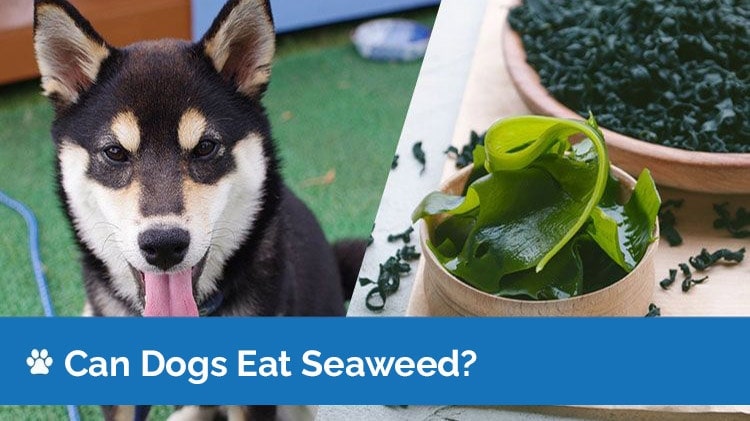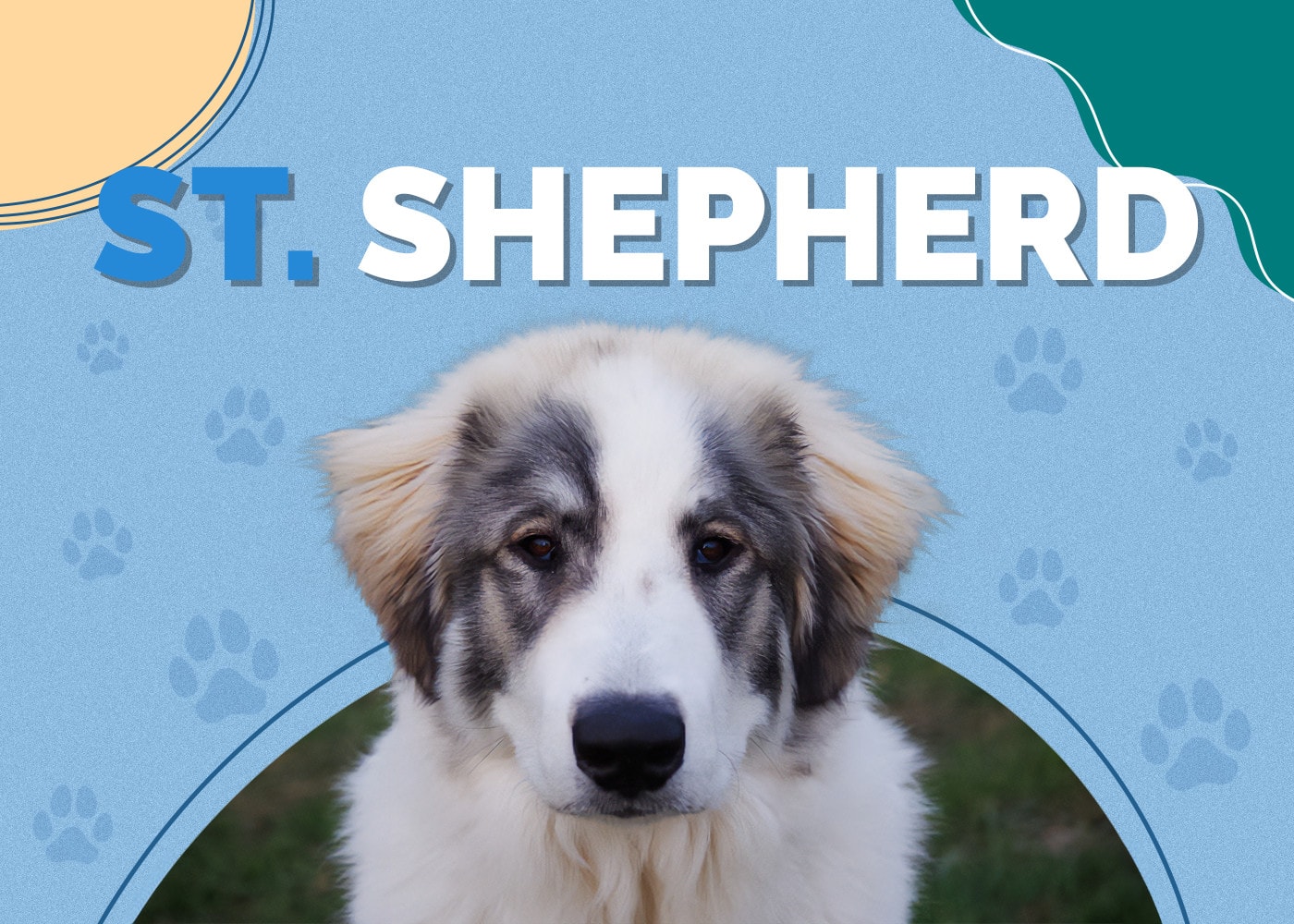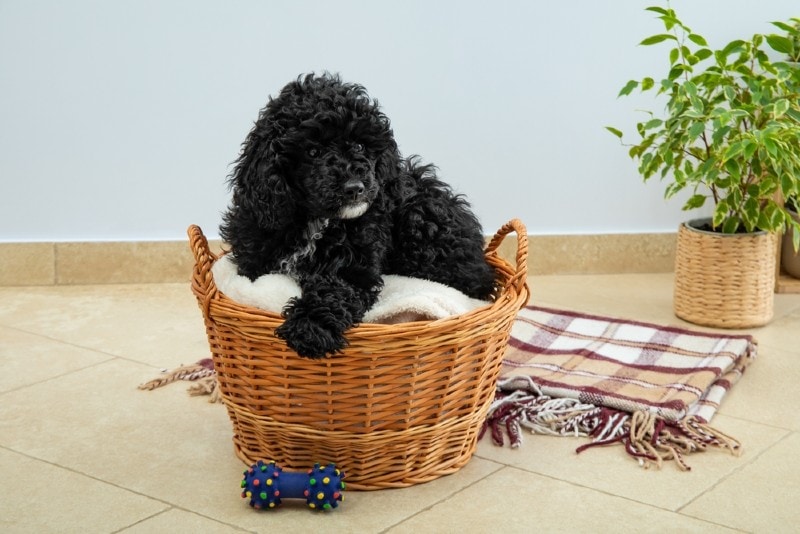6 Aussiedoodle Colors, Patterns & Coat Types (With Pictures)

Updated on
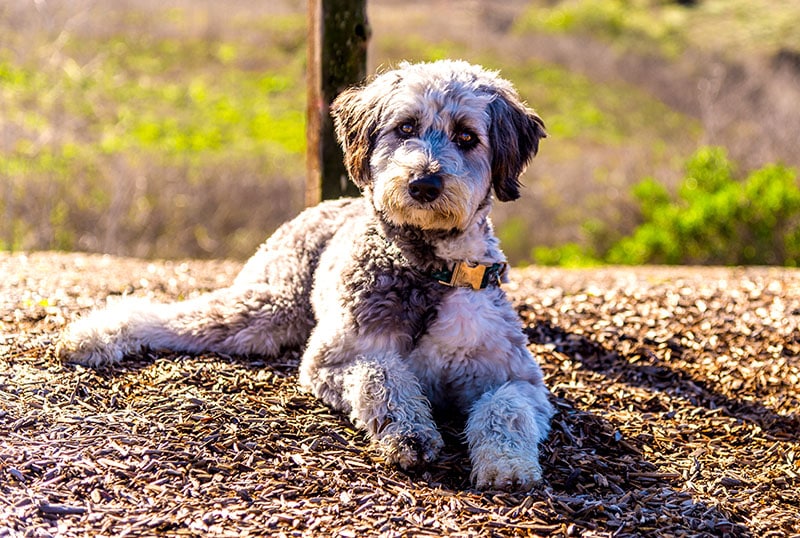
Click to Skip Ahead
Aussiedoodles are a delightful breed of dogs that are loved by many. With their friendly and playful personalities, it is hard not to fall in love with them. But what makes Aussiedoodles stand out from other breeds is their unique coat types and colors. With all the solid colors and complex patterns, Aussiedoodles come in a wide range of coat variations that make each dog special. Let’s take a look at some of the common colors and coat types of these gorgeous pups.
The 6 Aussiedoodle Colors & Patterns
1. Solid Color Aussiedoodles
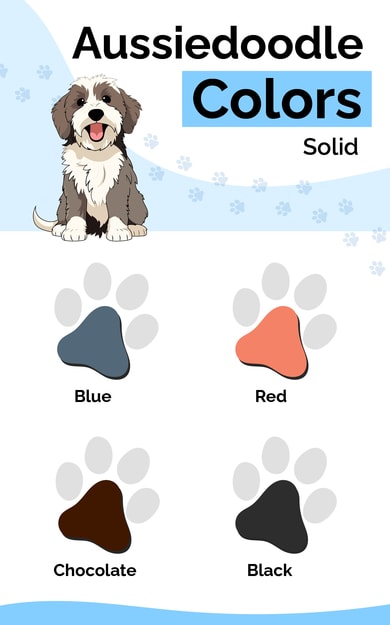
Solid color Aussiedoodles are one of the most common coat types and come in different shades. The most popular solid colors are black, blue, chocolate, and red. The coats of these Doodles are pretty consistent throughout and don’t have any markings or patterns. They’re perfect for anyone who prefers a simple and elegant look for their dogs. Aussiedoodles with solid coats will typically require grooming, though they don’t actually shed a lot.
2. Merle Aussiedoodles

These Aussiedoodles have a unique coat pattern that consists of a base color with patches of a darker color. The darker patches are usually in a swirled or marble pattern. The most common merle colors are blue merle, red merle, and chocolate merle. Merle Aussiedoodles are strikingly beautiful and are a popular choice for those who want a unique-looking dog. However, it’s important to note that some merle Aussiedoodles may be prone to health issues, such as deafness and blindness, so it’s essential to get a puppy from a reputable breeder.
3. Parti Aussiedoodles

Parti Aussiedoodles have a coat that’s sort of a combination of two colors, with one color being the base and the other color appearing in patches or spots. The most common parti colors are black and white, blue merle and white, and red and white. Parti Aussiedoodles have a playful and fun look that makes them popular all around the globe. They don’t shed much, but their coats can get matted, so it’s best to brush them weekly.
4. Phantom Aussiedoodles

Phantom Doodles have a base coat color with markings that are usually on the face, legs, and chest. The markings are usually a darker shade of the base color. The most common phantom colors are black phantom and red phantom. Phantom Aussiedoodles have a striking look that makes them stand out from other breeds. These gorgeous dogs can cost anywhere from $1,800 to over $3,200 because of their amazing colors.
5. Sable Aussiedoodles

Sable Aussiedoodles have a coat color that is unique and almost looks like a mix of milk chocolate and dark chocolate. Their coat color has a base color with black-tipped hairs. The most common sable colors are black sable, blue sable, and red sable. Their eyes are typically blue or light brown, giving them a striking appearance. Their coats are usually wavy and less prone to shedding, like many of the Aussiedoodle pups. These dogs may be harder to find, and as a result, you may find yourself being hit with a rather high price tag –one well into the thousands.
6. Tri-color Aussiedoodles

Tri-color Aussiedoodles have a coat that consists of three colors, usually black, red, tan, or white. The base color is usually white, with the other two colors appearing in patches or spots. Tri-color Aussiedoodles are strikingly beautiful and are a popular choice for those who want a unique-looking dog. Because of their unique color pattern these dogs can also fetch a pretty high price tag, often starting at about $1,800 for a puppy.
The 4 Different Aussiedoodle Coat Types
Aussiedoodles don’t generally shed a lot, but they’ll require regular grooming to keep their coats from getting matted – something that can make them harder to groom when you finally brush them. The type of coat a dog has will determine the grooming requirements.
- Straight Coats – A straight Doodle coat will need to be brushed at least once a week to keep it detangled and prevent clumping and matting that can often occur with these pup’s fur. Use a slicker brush to remove any tangles or mats in the fur. You can also use a comb to remove any loose hair. Straight coats don’t require trimming, but you may need to trim the hair around the paws, ears, and in front of their eyes.
- Wavy Coats – If your Aussiedoodle has a wavy coat, as so many do, it’ll usually require brushing at least two to three times a week to keep it from matting and shiny. You can also use a slicker brush for this type of coat and even a comb for loose hair (it’ll help remove dander). Generally, these coats will require a trimming and a grooming session about every 3 to 4 months to keep the fur from becoming too long.
- Curly Coats – Curly coats typically only require weekly brushing. With these coats, dander and loose hair will be minimal, but you’ll need to brush it to prevent it from becoming matted, particularly after the dog gets wet. These coats will generally need trimming every 6 to 8 weeks to keep your dog from looking like an Angora goat. And be sure to use your slicker brushes, combs, and de-matting gloves to keep this coat type from becoming tangled and matted.
- Corded Coats – Corded coats are those with straighter wave patterns, and they almost have a stringy appearance and consistency. These coats will also require weekly grooming/brushing. In addition to this, a trim with the groomer will be required about every 2 months to keep their fur from covering their paw pads and face. Note that corded coats require special grooming, and you may need to seek professional help to keep the cords healthy and clean. These coats can easily become tangled and matted, so keeping them trimmed is essential to your dog’s health.

Frequently Asked Questions (FAQ)
Does an Aussiedoodle shed a lot?
Not generally as much as other dog breeds. This breed is known for its hypoallergenic coat, which means they shed less than other breeds. However, the amount of shedding can vary from dog to dog, depending on their coat type and genetics. Some Aussiedoodles may shed more than others due to their genes inherited from their parents. But it’s also important to note that the amount of shedding can depend on the season. During the summer months, Aussiedoodles may shed more as they shed their winter coats. Regular grooming and brushing can help reduce shedding, as it removes loose fur before it falls off on its own.
Can I trim my Aussiedoodle’ fur myself?
The simple answer is yes, but it requires proper equipment and technique. Before starting the grooming process, it is essential to invest in high-quality scissors and clippers that are suitable for your dog’s coat type (i.e., straight, wavy, curly, or corded). It’s also important to have a clear idea of the desired length of the coat and to avoid cutting too close to the skin, which can cause injury to your pup. Next, it’s best to start by brushing out any tangles or mats in the fur before trimming. This can help prevent discomfort for the dog and ensure a smoother cut. It may even help to check out some grooming videos on YouTube before venturing into this territory for the first time.
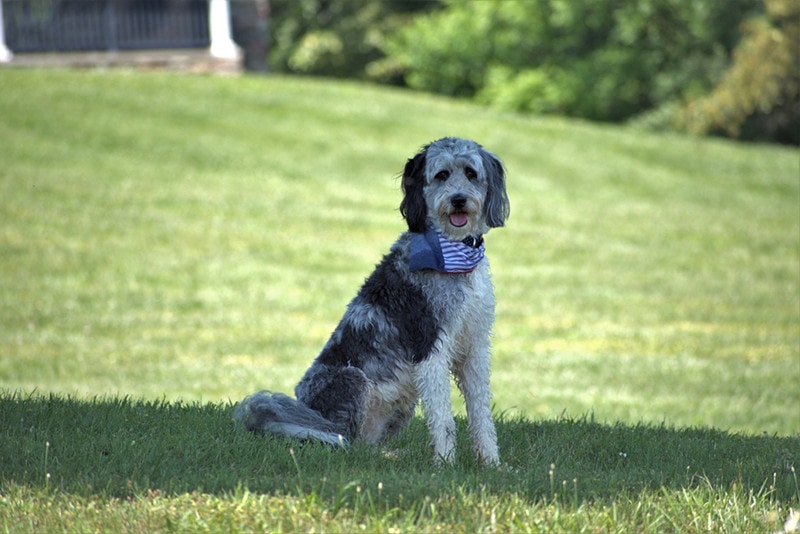
Do Aussiedoodles lose their puppy fur?
Yes, they do actually. As Aussiedoodles grow older, they shed their puppy fur and develop their adult coat. This process usually happens anywhere between the ages of 6 to 12 months. During the transition from puppy to adult coat, Doodles may experience some shedding. However, this shedding is usually not that excessive and can be managed with regular grooming. The adult coat of a Doodle is usually thicker and more curly than their puppy coat. The texture and color of the coat may also change as they mature. While some Aussiedoodles may resemble one parent more than the other, most will have a combination of both breeds’ characteristics – including coat type.
Do Aussiedoodles have a double coat?
The answer to this question isn’t really that straightforward, as it can vary from dog to dog. Some Aussiedoodles may have a double coat, while others may have a single coat. The coat type depends on the genetics of the individual dog and the traits inherited from its parent breeds. Generally, Australian Shepherds have a double coat, while Poodles have a single coat. However, the coat type of an Aussiedoodle can range from wavy to curly, depending on the traits inherited from each parent. A wavy or curly coat may appear thicker and denser, giving the impression of a double coat. Regardless of their coat type though, Doodles will require regular grooming to keep their coats healthy and tangle/matting free.
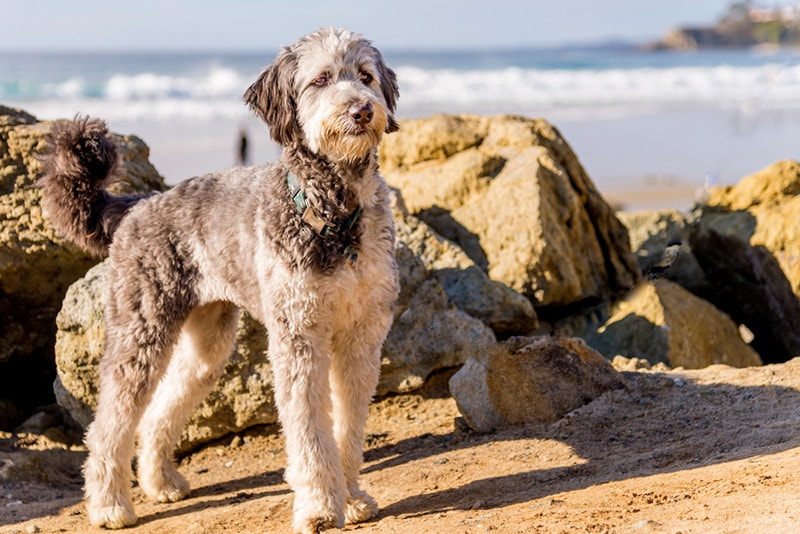
Why are Aussiedoodles so expensive?
Aussiedoodles have become increasingly popular in recent years, and with that popularity, their price has skyrocketed – social media has played a big part in this. There are several reasons why Aussiedoodles are so expensive. First, they’re a “designer breed” of dog, which means they’re the result of crossbreeding two purebred dogs. This breeding process involves a lot of time, effort, and resources to ensure that the resulting puppies are healthy and free from genetic defects.
Also, demand for Aussiedoodles is high, and supply is limited, which drives up the price. And lastly, reputable breeders who prioritize the health and wellbeing of their dogs will charge a premium for their puppies. So, what does this look like exactly? Well, for example, they invest in high-quality dog food, vet care, and genetic testing to ensure that their puppies are healthy and well-socialized before they go to their future parents’ homes.
Do Aussiedoodles need bathing?
Yes, they do. But the frequency of baths will depend on a variety of factors such as the dog’s activity level, coat type (as mentioned earlier, this can vary), and overall health. Regular bathing is an essential part of keeping your Aussiedoodle healthy and clean. It helps to remove dirt, debris, and excess oils from the skin and coat, which can help prevent skin irritations and infections.
Most Doodles will require a bath every 2 to 4 months, but some may need more frequent baths if they’re particularly active or have a longer coat that’s prone to matting and tangling. And when giving your Doodle a bath, it’s important to use a mild shampoo that is specifically formulated for dogs. Don’t use human shampoos or harsh chemical-based products, as these can strip the natural oils from your dog’s skin and coat and cause dryness and irritation.

What issues are Aussiedoodles prone to?
Doodles are generally considered to be a healthy breed of dog. However, like all breeds, they can be prone to certain health issues. One issue that Doodles can be prone to is eye problems. Some dogs may develop cataracts or other eye conditions that can lead to vision loss. So, it’s important to have your dog’s eyes checked regularly by a vet to catch any issues early. These dogs can also be prone to allergies, which can manifest in skin irritations, itching, and ear infections. These allergies may be caused by food, pollen, or other environmental factors. And, like many dog breeds, another common issue is hip dysplasia. This is a condition in which the hip joint doesn’t develop properly, leading to pain and discomfort. It can be genetic, so be sure to ask your breeder if the parents have been screened for hip dysplasia.
Conclusion
So, as you can see Aussiedoodles are a beautiful breed of dogs that come in a wide range of coat types and unique, eye-catching colors. And these distinctions often mean that these dogs will come with a higher price tag. Don’t forget that these pups will also require regular brushing in most cases and grooming sessions about every 2 to 4 months to keep their fur from growing too long. Understanding the different coat types and colors of Aussiedoodles can help you appreciate the beauty of these dogs even more.
Featured Image Credit: Steve Bruckmann, Shutterstock



